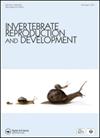Senescence in Acartia tonsa (Copepoda, Calanoida): male’s reproductive performance preliminary results from a southern population
IF 0.8
4区 生物学
Q4 REPRODUCTIVE BIOLOGY
引用次数: 4
Abstract
ABSTRACT The effect of age on fertilization capacity and reproductive potential were examined in males from a laboratory population of Acartia tonsa over their life time providing new empirical data for a foundational estuarine species. The reproductive functions spermatophore production (SPR), number of fertilized females (NFF), percentage of males that effectively fertilized females (M), egg production rate (EPR), and hatching success (EHS) were evaluated during the adult life of male A. tonsa, from maturation until advanced age (38 d) under controlled laboratory conditions. The ageing process of the male was manifested occurred as a general decrease in most of the reproductive functions, but these followed specific patterns: SPR did not decay significantly with advanced male age, as it did happen with NFF, M and EPR; EHS increased at an intermediate age. Those changes were out of phase: while EPR declined already at intermediate age, NFF and M evidenced a decline at more advanced ages. Results suggest that reproductive senescence in copepod males involves the interaction of several mechanisms whose study will require comprehensive approaches.唐Acartia tonsa(桡足目、大足目)的衰老:南方种群雄性繁殖性能的初步结果
摘要研究了年龄对印度洋Acartia tonsa实验室种群雄性在其一生中受精能力和繁殖潜力的影响,为一个基础河口物种提供了新的经验数据。在受控的实验室条件下,对雄性唐蛙成年后从成熟到高龄(38天)的生殖功能——精囊生成(SPR)、受精雌性数量(NFF)、有效受精雌性的雄性百分比(M)、卵子生成率(EPR)和孵化成功率(EHS)进行了评估。男性的衰老过程表现为大多数生殖功能的普遍下降,但这些都遵循特定的模式:SPR并没有像NFF、M和EPR那样随着男性年龄的增长而显著衰退;EHS在中年时增加。这些变化是不同步的:虽然EPR在中年时已经下降,但NFF和M在更高龄时下降。结果表明,桡足类雄性的生殖衰老涉及几个机制的相互作用,这些机制的研究需要综合的方法。
本文章由计算机程序翻译,如有差异,请以英文原文为准。
求助全文
约1分钟内获得全文
求助全文
来源期刊
CiteScore
1.90
自引率
0.00%
发文量
21
审稿时长
>12 weeks
期刊介绍:
Invertebrate Reproduction & Development ( IRD) presents original research on the reproductive and developmental biology of the Invertebrata, both embryonic and postembryonic. IRD welcomes papers reporting significant results obtained using new techniques. Encouraged topic areas include: aquaculture, physiology, biochemistry, functional morphology, phylogeny, behavioural and regulatory mechanisms, including genetic, endocrine and molecular studies. Papers containing qualitative descriptions of reproductive cycles and gametogenesis will not be considered. IRD is published in association with the International Society of Invertebrate Reproduction and Development.

 求助内容:
求助内容: 应助结果提醒方式:
应助结果提醒方式:


